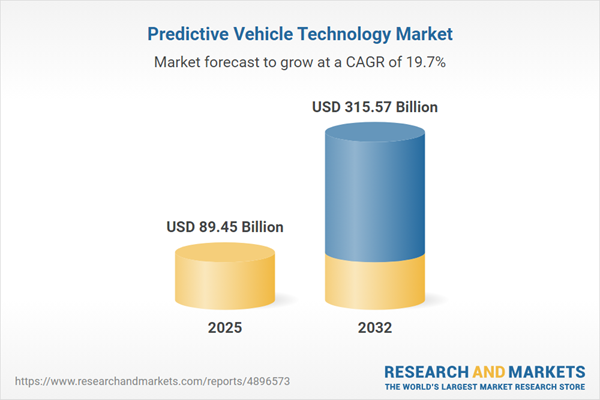Speak directly to the analyst to clarify any post sales queries you may have.
Predictive vehicle technology is driving significant change in fleet and mobility management, equipping senior leaders with advanced analytics for effective risk assessment and operational agility. As companies adapt to new industry demands and regulatory pressures, these solutions enable more strategic, data-informed transportation decisions.
Market Snapshot: Predictive Vehicle Technology Market Growth
The predictive vehicle technology market is experiencing robust growth, spurred by increased investments from automotive manufacturers and fleet operators. Shifting regulations and the evolution of transportation logistics are central factors impacting this expansion. Organizations are navigating complex compliance challenges by adopting digital solutions that enhance visibility and adaptability. The competitive landscape prioritizes advanced risk management as companies leverage updated mobility tools to remain responsive within dynamic environments.
Scope & Segmentation: Detailed Market Breakdown
- Technology: Artificial intelligence powers predictive vehicle systems, utilizing deep learning and machine learning to support real-time analytics and informed operational decisions.
- Sensor Arrays: Camera, LiDAR, radar, and ultrasonic sensors gather vehicle and environmental data to enable automation, improve driver assistance, and deliver safer fleet operations.
- Telematics & Diagnostics: Remote monitoring platforms provide predictive maintenance capabilities to increase reliability and maintain optimal performance across diverse vehicle fleets.
- Application: Solutions address driver behavior analysis, maintenance forecasting, collision mitigation, and route optimization, enhancing both regulatory compliance and logistics efficiency.
- Vehicle Types: Applicable for commercial fleets, passenger cars, and two-wheelers, these technologies fulfill the operational requirements of standard and specialized business models.
- Communication Technology: Real-time data exchange supported through 3G, 4G, and 5G networks ensures seamless connectivity between vehicles and management teams in varying conditions.
- Region: Adoption is global, with the Americas, Europe, Middle East & Africa, and Asia-Pacific leading uptake. The United States, Canada, Germany, China, and India play a prominent role in pioneering regional compliance strategies.
- Key Companies: The market includes both hardware and software leaders such as Robert Bosch GmbH, Continental AG, DENSO Corporation, Aptiv PLC, ZF Friedrichshafen AG, Valeo SA, NVIDIA Corporation, Intel Corporation, Harman International, and Trimble Inc., each delivering tailored solutions for evolving fleet demands.
This segmentation enables decision-makers to align investments with compliance priorities, efficiency benchmarks, and the operational demands of a transforming mobility sector.
Key Takeaways for Senior Decision-Makers
- Artificial intelligence paired with diverse sensor arrays delivers actionable insights to enhance both fleet safety and operational performance across multiple vehicle segments.
- Strategic collaboration between manufacturers and technology providers streamlines regulatory compliance and helps organizations adapt to fast-changing standards and logistics requirements.
- Advanced telematics and predictive diagnostics strengthen oversight, enabling preventative maintenance and reducing vehicle downtime through centralized, live connectivity.
- Enhanced supply chain processes, supported by predictive technology, increase resilience and provide the agility needed to adjust to shifting policies or unexpected disruptions.
- Scalable solutions promote rapid adaptation to regulatory changes, supporting tangible improvements in regional and global mobility operations.
Tariff Impact: Navigating U.S. Policy Changes in 2025
Recent amendments to U.S. tariffs on predictive vehicle technology components are affecting procurement strategies and budget distribution. To mitigate these impacts, organizations are diversifying suppliers, promoting local engagements, and incorporating open software ecosystems. These actions increase supply chain flexibility and foster preparedness for future policy adjustments.
Methodology & Data Sources
This report integrates quantitative market metrics with qualitative perspectives from interviews with industry executives and technical experts. Data is thoroughly validated against industry standards and corroborated with independent research. This approach ensures the reliability and relevance of information presented to decision-makers.
Why This Predictive Vehicle Technology Report Matters
- Equips senior leaders with targeted intelligence for preparing strategies that anticipate regulatory and operational changes.
- Clarifies market dynamics, competitor directions, and partnership opportunities, enabling effective navigation through a fast-evolving commercial environment.
- Strengthens organizational resilience and compliance preparedness amid continued technological evolution and market adaptation.
Conclusion
This report supports senior decision-makers in advancing predictive vehicle technology adoption, offering strategic guidance to optimize mobility frameworks as industry complexity grows.
Additional Product Information:
- Purchase of this report includes 1 year online access with quarterly updates.
- This report can be updated on request. Please contact our Customer Experience team using the Ask a Question widget on our website.
Table of Contents
3. Executive Summary
4. Market Overview
7. Cumulative Impact of Artificial Intelligence 2025
Companies Mentioned
The companies profiled in this Predictive Vehicle Technology market report include:- Robert Bosch GmbH
- Continental AG
- DENSO Corporation
- Aptiv PLC
- ZF Friedrichshafen AG
- Valeo SA
- NVIDIA Corporation
- Intel Corporation
- Harman International Industries, Inc.
- Trimble Inc.
Table Information
| Report Attribute | Details |
|---|---|
| No. of Pages | 198 |
| Published | October 2025 |
| Forecast Period | 2025 - 2032 |
| Estimated Market Value ( USD | $ 89.45 Billion |
| Forecasted Market Value ( USD | $ 315.57 Billion |
| Compound Annual Growth Rate | 19.7% |
| Regions Covered | Global |
| No. of Companies Mentioned | 11 |









